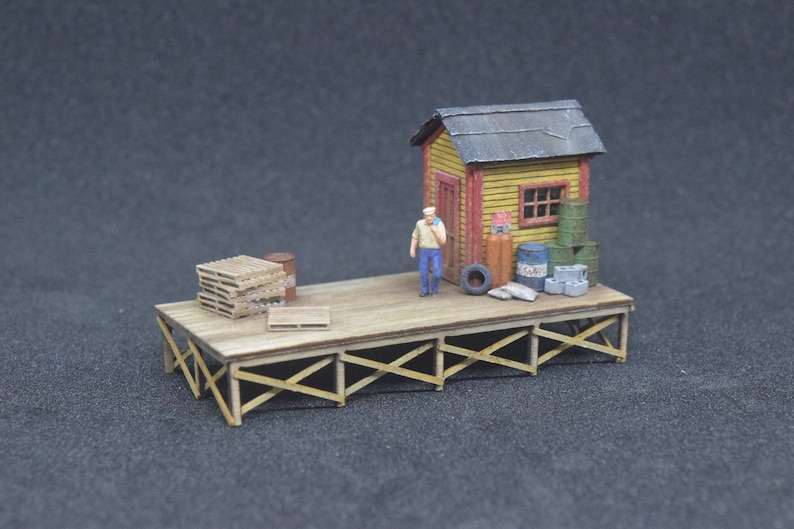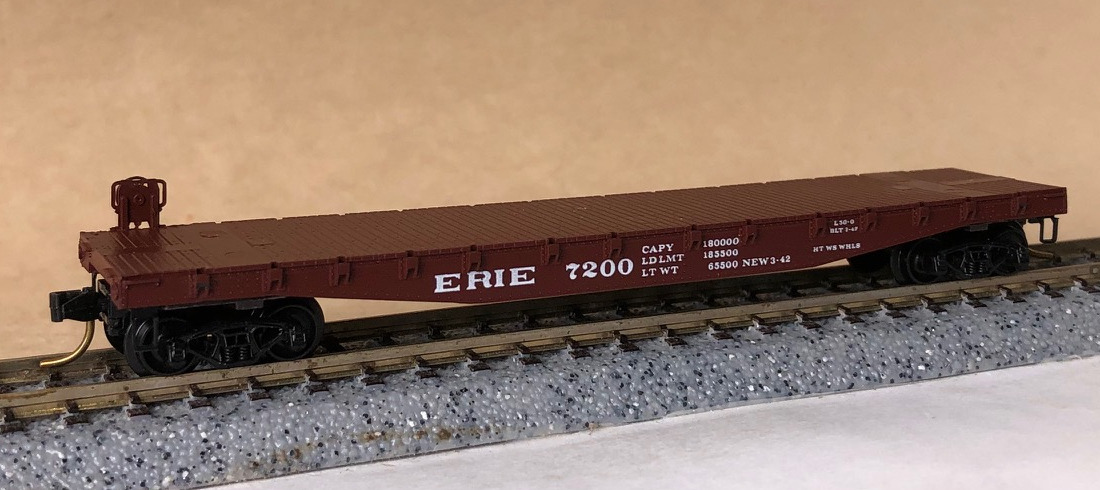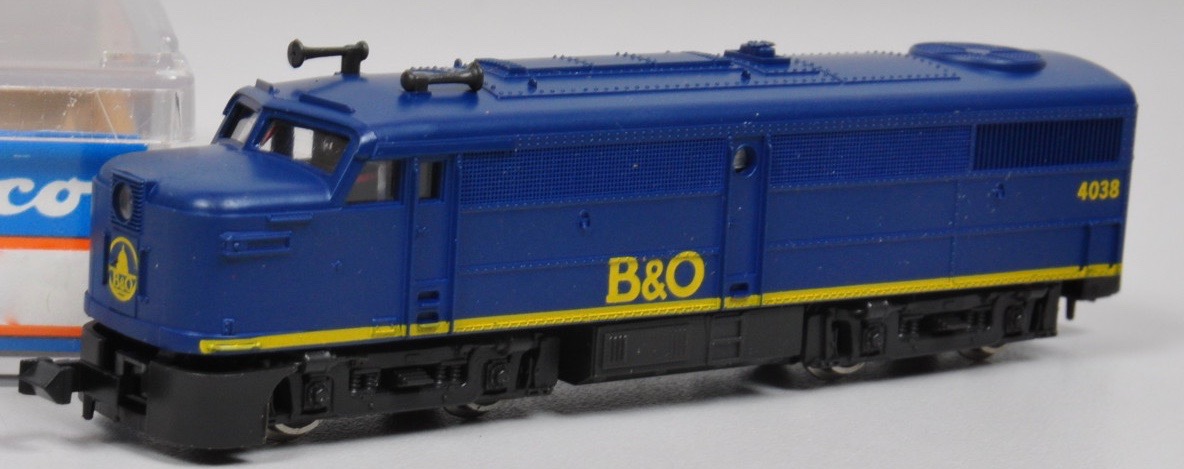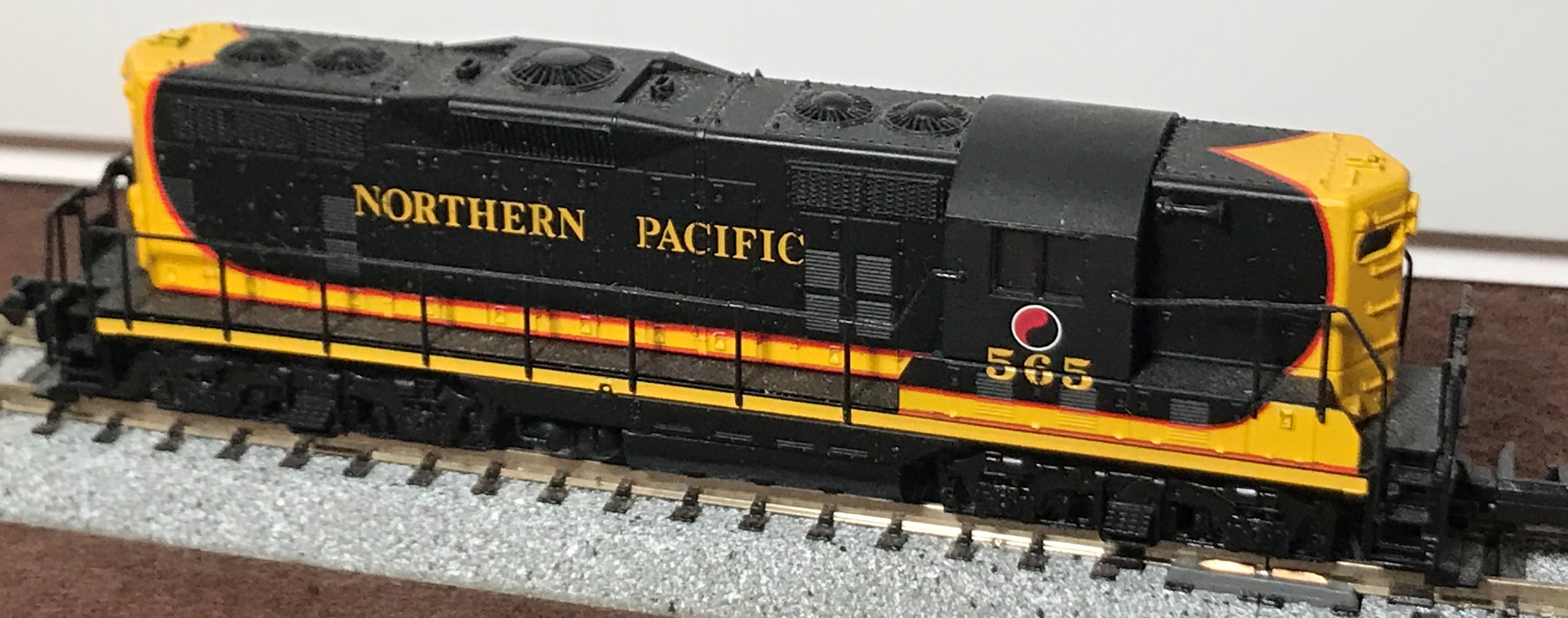Specific Item Information: Handrails delivered unmounted
Model Information: This model was first announced in the Arnold 1967-68 catalog, together with the GP7 and GP30, all three sharing the same mechanism. Initially offered in one livery per model, these models were subsequently offered with additional roadnames as shown in the 1968-69 catalog.
It was introduced as Revell Rapido, and offered under the usual Arnold Rapido branding after Revell stopped cooperation with Revell circa 1973.
The model was revised circa 1985 with a new motor but no notable other changes. More roadnames were introduced at that occasion.
Arnold decided that GP7 was without dynamic brakes and that GP9 will have them, hence the dynamic brake blister on the roof that was systematically delivered in black regardless of the locomotive color.
The 1985 run can be distinguished from the original one with one spotting feature: the louvers under the cab have disappeared, which seems more like the prototype.
Overall this model is reported as an average or poor runner at slow speed, though it can pull quite many cars thanks to its generous weight.
No lights.
It was introduced as Revell Rapido, and offered under the usual Arnold Rapido branding after Revell stopped cooperation with Revell circa 1973.
The model was revised circa 1985 with a new motor but no notable other changes. More roadnames were introduced at that occasion.
Arnold decided that GP7 was without dynamic brakes and that GP9 will have them, hence the dynamic brake blister on the roof that was systematically delivered in black regardless of the locomotive color.
The 1985 run can be distinguished from the original one with one spotting feature: the louvers under the cab have disappeared, which seems more like the prototype.
Overall this model is reported as an average or poor runner at slow speed, though it can pull quite many cars thanks to its generous weight.
No lights.
DCC Information: No DCC support; not invented yet in 1968.
Prototype History: An EMD GP9 is a four-axle diesel-electric locomotive built by General Motors' Electro-Motive Division in the United States, and General Motors Diesel in Canada between January, 1954, and August, 1963. US production ended in December, 1959, while an additional thirteen units were built in Canada, including the last two in August, 1963. Power was provided by an EMD 567C sixteen-cylinder engine which generated 1,750 horsepower (1.30 MW). This locomotive type was offered both with and without control cabs; locomotives built without control cabs were called GP9B locomotives. All GP9B locomotives were built in the United States between February, 1954, and December, 1959.
One option available for locomotives without dynamic brakes, was to remove the two 22.5 in × 102 in (571.5 mm × 2,590.8 mm) air reservoir tanks from under the frame, and replace them with four 12 in × 150.25 in (304.80 mm × 3,816.35 mm) tanks that were installed on the roof of the locomotive, above the prime mover. These “torpedo tubes” as they were nicknamed, enabled the fuel and water tanks to be increased to 1,100 US gallons (4,200 l; 920 imp gal) each, although some railroads opted for roof-mounted air tanks and 2,200 US gallons (8,300 l; 1,800 imp gal) fuel tanks on their freight ‘Geeps’.
From Wikipedia
One option available for locomotives without dynamic brakes, was to remove the two 22.5 in × 102 in (571.5 mm × 2,590.8 mm) air reservoir tanks from under the frame, and replace them with four 12 in × 150.25 in (304.80 mm × 3,816.35 mm) tanks that were installed on the roof of the locomotive, above the prime mover. These “torpedo tubes” as they were nicknamed, enabled the fuel and water tanks to be increased to 1,100 US gallons (4,200 l; 920 imp gal) each, although some railroads opted for roof-mounted air tanks and 2,200 US gallons (8,300 l; 1,800 imp gal) fuel tanks on their freight ‘Geeps’.
From Wikipedia
Road Name History:  Although they may be molded in color, unpainted and unlettered, undecorated products are marketed to modelers who seek to custom decorate their models for private roads and/or road and/or company names that were not commercially produced by any of the major manufacturers.
Although they may be molded in color, unpainted and unlettered, undecorated products are marketed to modelers who seek to custom decorate their models for private roads and/or road and/or company names that were not commercially produced by any of the major manufacturers.
Undecorated models are frequently also unassembled or only partially assembled and required modelers to be comfortable with glue, paint and sometimes solder in order to prepare their models for display. Materials for these models can vary but often include plastic, pewter and resin. Models may or may not come with decals or other decorations such as plastic signage, railings and ladders to enhance the appearance of the final product.

Undecorated models are frequently also unassembled or only partially assembled and required modelers to be comfortable with glue, paint and sometimes solder in order to prepare their models for display. Materials for these models can vary but often include plastic, pewter and resin. Models may or may not come with decals or other decorations such as plastic signage, railings and ladders to enhance the appearance of the final product.
Brand/Importer Information:  Founded in 1906 by Karl Arnold in Nuernberg, K. Arnold & Co. began its life producing tin toys and related items. They produced an extensive line of model ships, doll house items and other toys. In 1935, K. Arnold & Co. hired Max Ernst as their managing director. Ernst, not to be confused with the German realist artist of the same name, was a significant factor in the future of Arnold.
Founded in 1906 by Karl Arnold in Nuernberg, K. Arnold & Co. began its life producing tin toys and related items. They produced an extensive line of model ships, doll house items and other toys. In 1935, K. Arnold & Co. hired Max Ernst as their managing director. Ernst, not to be confused with the German realist artist of the same name, was a significant factor in the future of Arnold.
There are several distinct phases of Arnold's model train production. In the period of 1960 - 1962, Arnold marketed the Arnold Rapido 200 product line; this line was very crude yet it also was a sensation because of its much smaller size than TT.
The next phase was from 1963-1967, when the rapido product line begins to swing toward scale representations of the trains. It is during this period that the "Rapido Coupler" comes into production, beginning its widespread use by all model train manufacturers in N-Scale. It was in 1964 that the term "N-Scale" came into use. Between 1968 and 1970, rapido line of trains reached maturity, notably with its turntable and roundhouse. Arnold entered into a business relationship with the U.S. company Revell around 1968, beginning the marketing of Revell Rapido model trains. This relationship was marked by the beginning of production of more accurate North American prototype models by Arnold. This relationship continued for several years, ending in the late 1960s or early 1970s. Arnold continued their expanded production, with new models until the early 1990s.
On Max Ernst's 1976 retirement, Arnold employed perhaps 200 to 250 people, using three facilities in the Nurnberg area. The Company continued under family control until 1995, when Arnold went into bankruptcy and was sold to Rivarossi of Italy. Rivarossi, in turn, also went bankrupt, leading to the sale of all assets to Hornby of the United Kingdom. Production is carried out in China.

There are several distinct phases of Arnold's model train production. In the period of 1960 - 1962, Arnold marketed the Arnold Rapido 200 product line; this line was very crude yet it also was a sensation because of its much smaller size than TT.
The next phase was from 1963-1967, when the rapido product line begins to swing toward scale representations of the trains. It is during this period that the "Rapido Coupler" comes into production, beginning its widespread use by all model train manufacturers in N-Scale. It was in 1964 that the term "N-Scale" came into use. Between 1968 and 1970, rapido line of trains reached maturity, notably with its turntable and roundhouse. Arnold entered into a business relationship with the U.S. company Revell around 1968, beginning the marketing of Revell Rapido model trains. This relationship was marked by the beginning of production of more accurate North American prototype models by Arnold. This relationship continued for several years, ending in the late 1960s or early 1970s. Arnold continued their expanded production, with new models until the early 1990s.
On Max Ernst's 1976 retirement, Arnold employed perhaps 200 to 250 people, using three facilities in the Nurnberg area. The Company continued under family control until 1995, when Arnold went into bankruptcy and was sold to Rivarossi of Italy. Rivarossi, in turn, also went bankrupt, leading to the sale of all assets to Hornby of the United Kingdom. Production is carried out in China.
Item created by: Alain LM on 2018-12-15 12:42:29. Last edited by gdm on 2020-07-24 07:29:20
If you see errors or missing data in this entry, please feel free to log in and edit it. Anyone with a Gmail account can log in instantly.
If you see errors or missing data in this entry, please feel free to log in and edit it. Anyone with a Gmail account can log in instantly.









